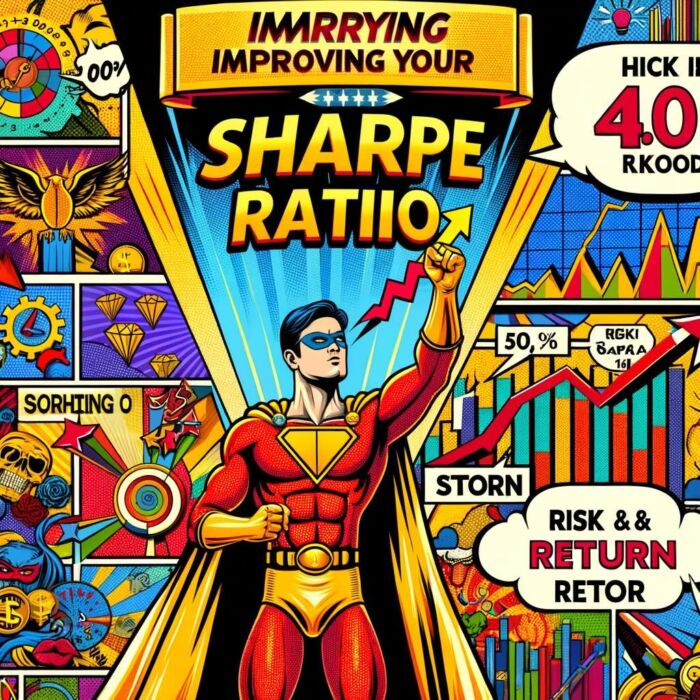Investing in uncorrelated asset classes and employing uncorrelated investment strategies can provide a number of benefits for investors seeking to diversify their portfolios and manage risk. Uncorrelated assets and strategies are those that have low or negative correlation with traditional asset classes such as stocks and bonds. This means that they tend to move independently of these asset classes, which can help to reduce overall portfolio volatility and improve risk-adjusted returns.

Let’s Define Uncorrelated Asset Classes and Uncorrelated Investing Strategies

Investing can be a confusing and daunting task, especially when you start hearing words like “uncorrelated asset class” or “uncorrelated strategy”. But fear not, my friends! In this post, we’re going to break down exactly what these terms mean and why they are important for investors.
First things first, let’s define what we mean by “uncorrelated”. In the world of finance, correlation refers to the degree to which the prices of different assets move in tandem with each other. If two assets have a correlation of 1, that means they move in perfect lockstep with each other.

Uncorrelated Assets and Correlations
On the other hand, if two assets have a correlation of -1, that means they move in exact opposite directions. An uncorrelated asset class or strategy is one that has little to no correlation with traditional asset classes like stocks or bonds.
So, why would you want to invest in an uncorrelated asset class or strategy? Well, for starters, it can help to reduce the overall risk of your portfolio. If all of your investments are in the same asset class, then you are subject to the same market forces and risks. However, if you diversify your portfolio with uncorrelated assets, then you can potentially reduce your overall risk.
source: Longboard Asset Management on YouTube

The Benefits Of Diversification & Enhanced Potential Portfolio Performance
One of the main benefits of investing in uncorrelated assets is the potential to improve portfolio diversification. By adding uncorrelated assets to a portfolio, investors can reduce the risk of losses due to market volatility. For example, during a stock market downturn, uncorrelated assets such as real estate or commodities may not be affected in the same way as stocks and bonds, providing a buffer against losses.
Another advantage of uncorrelated assets is their potential to improve overall portfolio performance. By diversifying across a range of uncorrelated asset classes, investors can potentially improve their risk-adjusted returns over the long-term. This is because uncorrelated assets may provide returns that are not correlated with traditional asset classes, allowing investors to capture different sources of return.
Employing uncorrelated investment strategies can also provide benefits for investors. For example, trend-following strategies are designed to capture market trends and generate returns independent of market direction.

Up and Down Market Performance With Uncorrelated Strategies
By using these types of strategies, investors can potentially generate returns in both up and down markets, improving the overall performance of their portfolios.
Other uncorrelated investment strategies include merger arbitrage, which involves profiting from the price discrepancies between companies involved in a merger or acquisition, and managed futures, which use futures contracts to invest in a variety of asset classes.
However, it is important to note that investing in uncorrelated assets and strategies is not without risk. Uncorrelated assets can still experience losses, and uncorrelated investment strategies can also suffer from periods of underperformance.
Overall, incorporating uncorrelated asset classes and uncorrelated investment strategies into a portfolio can provide benefits for investors seeking to diversify their portfolios and manage risk. By carefully selecting a range of uncorrelated assets and strategies and regularly rebalancing their portfolios, investors can potentially improve their overall investment outcomes over the long-term.
source: fu academy on YouTube

20 Uncorrelated Asset Classes and Investing Strategies
Here are 20 uncorrelated asset classes and investing strategies, along with a brief description of each:
- Real Estate: Investing in physical property, such as commercial or residential real estate, can provide a source of income and capital appreciation that is generally uncorrelated with the stock market.
- Commodities: Investing in commodities such as gold, oil, or agricultural products can provide a hedge against inflation and diversify a portfolio away from stocks and bonds.
- Managed Futures: These strategies use futures contracts to invest in a variety of asset classes, including commodities, currencies, and interest rates.
- Trend Following: This strategy involves identifying and following market trends, with the goal of generating returns independent of market direction.
- Long-Short Equity: This strategy involves taking both long and short positions in individual stocks or sectors, with the goal of generating returns from both rising and falling markets.
- Market Neutral: This strategy involves taking both long and short positions in two highly correlated stocks or sectors, with the goal of generating returns from relative performance differences.
- Multi-Factor: This strategy uses multiple factors, such as value, momentum, and quality, to identify stocks or sectors that are likely to outperform the market.
- Options: This strategy involves buying or selling options contracts to hedge against potential losses or generate income from market volatility.
- Volatility: This strategy involves investing in volatility derivatives, such as options or futures contracts, to profit from changes in market volatility.
- Merger Arbitrage: This strategy involves profiting from the price discrepancies between companies involved in a merger or acquisition.
- Private Equity: This involves investing in private companies, with the goal of generating returns from growth or through the sale of the company.
- Distressed Debt: This strategy involves investing in the debt of financially troubled companies, with the goal of generating returns from the eventual recovery or restructuring of the company.
- Real Estate Investment Trusts (REITs): These are investment vehicles that hold portfolios of real estate properties and are traded like stocks.
- Fine Art: Investing in fine art can provide a source of alternative returns that is generally uncorrelated with the stock market.
- Wine: Investing in fine wines can provide a source of alternative returns that is generally uncorrelated with the stock market.
- Peer-to-Peer Lending: This strategy involves lending money to individuals or businesses through online platforms, with the goal of generating returns from interest payments.
- Infrastructure: Investing in infrastructure projects, such as toll roads or power plants, can provide a source of income that is generally uncorrelated with the stock market.
- Renewable Energy: Investing in renewable energy projects, such as solar or wind power, can provide a source of income that is generally uncorrelated with the stock market.
- Insurance-Linked Securities: These are securities that are tied to insurance contracts, such as catastrophe bonds, and can provide a source of income that is generally uncorrelated with the stock market.
- Royalties: Investing in intellectual property royalties, such as music or book royalties, can provide a source of alternative returns that is generally uncorrelated with the stock market.
Keep in mind that investing in uncorrelated asset classes and strategies involves risk and should be done as part of a well-diversified portfolio with careful consideration of individual risk tolerance and investment goals.
source: Brainy Finance on YouTube

Improve Your Sharpe Ratio & Sortino Ratio
The Sharpe Ratio and the Sortino Ratio are two widely used metrics that investors use to evaluate the risk-adjusted returns of an investment. The Sharpe Ratio measures the excess return generated by an investment per unit of volatility, while the Sortino Ratio measures the excess return generated by an investment per unit of downside volatility.
Investors are always looking for ways to improve their risk-adjusted returns, and one way to do that is to add uncorrelated asset classes and strategies to their portfolio. Uncorrelated assets have low or no correlation to traditional asset classes, such as stocks and bonds. This means that they are less likely to move in the same direction as the broader market during times of market stress.
By adding uncorrelated assets to a portfolio, investors can reduce overall portfolio risk and increase diversification, which can lead to improved risk-adjusted returns. Let’s explore how the Sharpe Ratio and the Sortino Ratio can be improved with uncorrelated asset classes and strategies.

Improving the Sharpe Ratio with Uncorrelated Asset Classes and Strategies:
The Sharpe Ratio measures the excess return generated by an investment per unit of volatility. Adding uncorrelated asset classes and strategies to a portfolio can reduce the volatility of the portfolio, thus increasing the Sharpe Ratio. Here are a few examples of uncorrelated asset classes that can improve the Sharpe Ratio:
- Managed Futures: Managed Futures are investments that allow investors to gain exposure to commodities, currencies, and financial futures markets. This asset class is known for its low correlation to traditional asset classes and can provide diversification benefits to a portfolio.
- Private Equity: Private Equity investments are typically made in privately-held companies that are not publicly traded. Private Equity investments can provide diversification benefits to a portfolio due to their low correlation to traditional asset classes.
- Real Estate: Real Estate investments are a popular way to add diversification to a portfolio. Real Estate investments can include direct property ownership, REITs (Real Estate Investment Trusts), and Real Estate funds.

Improving the Sortino Ratio with Uncorrelated Asset Classes and Strategies:
The Sortino Ratio measures the excess return generated by an investment per unit of downside volatility. Adding uncorrelated asset classes and strategies to a portfolio can reduce the downside volatility of the portfolio, thus increasing the Sortino Ratio. Here are a few examples of uncorrelated asset classes that can improve the Sortino Ratio:
- Long/Short Equity: Long/Short Equity is a strategy that involves buying stocks that are expected to increase in value and shorting stocks that are expected to decrease in value. This strategy can provide diversification benefits to a portfolio due to its low correlation to traditional asset classes.
- Tail Risk Hedging: Tail Risk Hedging is a strategy that involves buying insurance against extreme market events. This strategy can provide diversification benefits to a portfolio by reducing downside risk during market stress.
- Options Trading: Options Trading is a strategy that involves buying and selling options contracts. This strategy can provide diversification benefits to a portfolio due to its low correlation to traditional asset classes.
Adding uncorrelated asset classes and strategies to a portfolio can provide diversification benefits, reduce overall portfolio risk, and improve risk-adjusted returns. The Sharpe Ratio and the Sortino Ratio are two widely used metrics that can be improved by adding uncorrelated assets to a portfolio. However, it is important to remember that uncorrelated assets and strategies come with their own risks and should be carefully considered before adding them to a portfolio.
source: The Evidence-Based Investor on YouTube

How To Be Patient + Stay The Course With Uncorrelated Investments
Investing in uncorrelated asset classes and investing strategies can be an effective way to diversify your portfolio and reduce risk. However, it is important to be patient and maintain a long-term outlook when investing in these types of assets.
First and foremost, it is crucial to set realistic expectations. While uncorrelated investments can offer diversification benefits, they may not always perform as well as traditional stocks and bonds. It’s important to have a clear understanding of the potential risks and rewards associated with each investment, and to adjust your expectations accordingly.
Additionally, uncorrelated asset classes and investing strategies often require a longer-term investment horizon. Investors should be prepared to hold onto these investments for several years, if not longer, in order to fully realize the benefits of diversification and reduced risk.
Inevitably, uncorrelated investments may experience short-term fluctuations that can be unsettling for investors. However, it is important to avoid making knee-jerk reactions during times of market volatility. Instead, focus on the long-term outlook for these investments and resist the urge to panic.
Understanding the risks associated with each investment is also key. While uncorrelated asset classes and investing strategies can offer diversification benefits, they come with their own set of risks. It’s important to carefully evaluate the risks associated with each investment, and to have a plan in place for managing those risks.

Staying Disciplined & Patient = Key To Success
To stay disciplined and patient when investing in uncorrelated assets, it’s important to have a well-defined investment strategy. This means having a plan for how much to invest in each asset class and sticking to that plan, even during times of market volatility. Regularly rebalancing your portfolio can also help you maintain a well-diversified portfolio and minimize risk.
Staying informed about the performance and outlook for uncorrelated asset classes and investing strategies is also important. By keeping up-to-date on market trends and news, you can make informed investment decisions and avoid making rash decisions based on short-term market movements.
Moreover, seeking professional advice can be helpful when investing in uncorrelated asset classes and investing strategies. Financial advisors and investment managers can provide valuable insight and guidance, helping you develop a well-diversified portfolio that is suited to your individual investment goals and risk tolerance.
source: Option Alpha on YouTube

Final Thoughts
In conclusion, investing in uncorrelated asset classes and investing strategies can offer significant benefits, but it is important to be patient and maintain a long-term outlook. By setting realistic expectations, understanding the risks, staying disciplined, staying informed, and seeking professional advice, investors can develop a patient and successful approach to investing in these types of assets.
Important Information
Investment Disclaimer: The content provided here is for informational purposes only and does not constitute financial, investment, tax or professional advice. Investments carry risks and are not guaranteed; errors in data may occur. Past performance, including backtest results, does not guarantee future outcomes. Please note that indexes are benchmarks and not directly investable. All examples are purely hypothetical. Do your own due diligence. You should conduct your own research and consult a professional advisor before making investment decisions.
“Picture Perfect Portfolios” does not endorse or guarantee the accuracy of the information in this post and is not responsible for any financial losses or damages incurred from relying on this information. Investing involves the risk of loss and is not suitable for all investors. When it comes to capital efficiency, using leverage (or leveraged products) in investing amplifies both potential gains and losses, making it possible to lose more than your initial investment. It involves higher risk and costs, including possible margin calls and interest expenses, which can adversely affect your financial condition. The views and opinions expressed in this post are solely those of the author and do not necessarily reflect the official policy or position of anyone else. You can read my complete disclaimer here.






